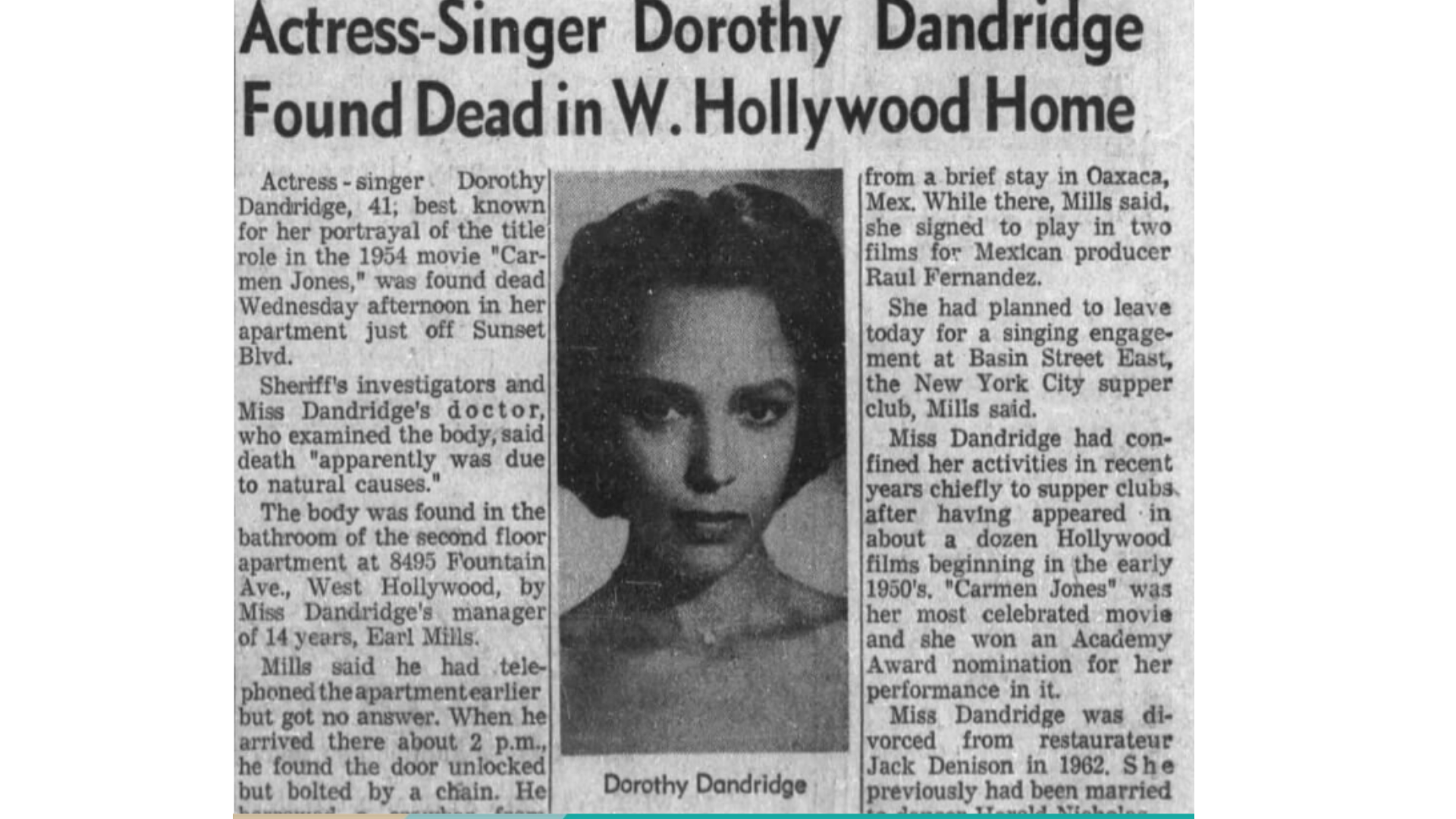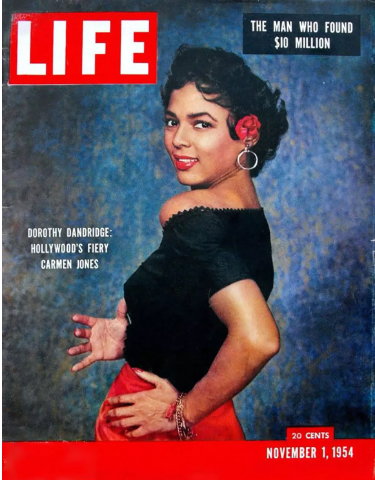
Many famous names have lived and/or died in West Hollywood over the years but few had lives as sad as that of singer/actress Dorothy Dandridge. If she had been born fifty years later, Dorothy might have been as successful as Beyonce or Halle Berry, but in her day Hollywood did not know what to do with a Black performer who possessed her talent, beauty and charisma.
Dorothy Dandridge began performing as a singer and dancer, pushed into the limelight by her domineering stage mother. As she grew into a dazzling beauty, Dorothy found solo success playing nightclubs and taking a few movie roles. Unfortunately, she found her choice of parts limited by her refusal to play slaves or maids.
What should have been Dorothy’s big break came in 1953 when she won the plum role of the fiery factory girl in the film version of Bizet’s opera “Carmen.” The Technicolor, wide-screen movie “Carmen Jones” had an all-Black cast that included Harry Belafonte and was directed by Otto Preminger. Dorothy’s image as a sophisticated saloon singer was not as earthy as what the director had in mind to play the leading lady role but the actress was so determined to land the part that she dressed and styled herself as the sexy Carmen Jones. This version of Dorothy made such an impression on the legendary director that he not only gave her the part, he began an affair with the actress that lasted for several years.
When the film was released, the studio spared no expense in splashing the image of Dorothy as Carmen Jones all over the press including the cover of Life magazine, something that didn’t happen back in the segregated fifties. Dorothy became the first African-American actress to be nominated for the Academy Award for Best Actress and also appeared on the telecast as a presenter.
This should have been the beginning of Dorothy’s career as a Hollywood leading lady but things didn’t work out that way because this was the 1950s and the movie industry was still catering to the tastes and prejudices of ticket buyers in the Deep South. That meant no physical contact between Black and white actors, limiting roles for African American performers to musical numbers that could be easily snipped out of films when they played theaters in the South. In 1957 Dorothy was part of a star-studded ensemble cast in “Island in the Sun” but was not allowed to show affection for the white actor who played her lover. Shut out of Hollywood success, Dorothy used her singing talent to play fashionable clubs but over the late 1950s her career slid downhill.
Her career was not the only source of stress in Dorothy’s life. Her first marriage to Harold Nicholas of the dancing Nicholas brothers was blighted by his infidelities and a daughter who was born developmentally disabled. The girl would require custodial care for her entire life, forcing her mother to earn enough money to keep her in private hospitals instead of state-run institutions. Her affair with Otto Preminger was a toxic one that eroded her self-esteem and confidence. Dorothy’s second husband Jack Denison ended after only three years and she discovered that her handlers had mismanaged her finances, forcing her into bankruptcy. She had to move her beloved daughter into a state mental institution, sell her Hollywood home and move into a small apartment in West Hollywood.
The combined weight of career frustration, romantic disappointments, financial disaster and caring for her daughter led Dorothy to soothe her misery with alcohol and pills. In 1964 Dorothy was working as a lounge act in Las Vegas to pay off her recent bankruptcy but things seemed to be looking up the next year as she signed a contract to make films in Mexico.
On September 8, 1965, Dorothy’s manager arrived at her apartment in the El Palacio on the corner of Fountain and La Cienega to pick her up and take her to an appointment. When she did not answer his knock, the manager pried the door open with a tire iron and found the actress’s nude body. Her cause of death was disputed and could have been either an accidental overdose of an antidepressant or a fat embolism from a recent foot fracture. She was 42 years old and had only $2.14 in the bank.
In the years since Dorothy’s tragic death, she has finally received some of the recognition that was denied her in life. She was awarded a posthumous star on the Hollywood Walk of Fame in 1984 and in 1999 Halle Berry produced and starred in the movie “Introducing Dorothy Dandridge” which netted her several awards. In 2002 Berry became the first African American actress to win the Oscar for Best Actress and acknowledged Dorothy Dandridge in her acceptance speech.
The El Palacio has always been one of my favorite buildings in West Hollywood and whenever I pass it I’m reminded of Dorothy Dandridge. The lady deserved better.



Thanks for the history lesson on Dorothy Dandridge.I have heard of her,but really didn’t know who she was about and her life.Glad to see she is getting much needed recognition.
I checked out The El Palacio apartments on-line and it is a very majestic building.The apartment building was built in the 1930s and its look was perfect for Hollywood of that time.Too bad it is across the street from those faceless apartments buildings.
Never heard of her.
“but in her day Hollywood did not know what to do with a Black performer who possessed her talent, beauty and charisma…” Really? Maybe the supremely talented Diana Ross and Eartha Kitt would disagree. Ugh, enough with unnecessarily adding “waycism” to every narrative. I may have enjoyed reading the article but had to stop once that trendy narrative surfaced. Lead with love.
You show your ignorance. Eartha didn’t get the opportunities she deserved either and Diana came along many years later. Get educated before you stand on your soapbox.
So are you saying that Jim Crow Laws had no effect on Black people in America? We’re talking 1957 here. The Voting Rights Act didn’t exist. Schools were still fighting integration. Diana Ross was 13 years old. Racism absolutely had an impact on Dorothy Dandridge’s career. I hope that your “love” will lead you to a history book or three.
The Supremes didn’t release their first album “Meet The Supremes” until late 1962. Diana Ross went out on her own several years later.
Lead with love? Every comment you make oozes with bitter hatred. Not to mention complete ignorance if you think Eartha Kitt had a successful film career or that Diana Ross was around in the 1950’s. Get your facts straight before you let your thumbs do the talking.
Let’s also remember that when Dorothy swam in a pool at a hotel in Las Vegas, the hotel had the pool drained and re-filled because a black person had been swimming in it.